Our understanding of science capital and how it affects engagement shaped our programme and gave us the confidence to try a new approach.
The UK has a serious shortage of science, technology, engineering and maths (STEM) skills. We wanted to address that skills gap by helping young people see that engineering skills are transferable and useful, whatever you want to do. It was important to give visitors the opportunity to get hands-on and practice their engineering skills, but it was equally important to help students recognise where they use these skills in everyday life. We know from experience that spotting science skills outside the classroom isn’t easy, so supporting students to make those links was at the forefront of our minds as we developed the programme.
Future Engineers was targeted at key stage 2 and 3 students, and families with children aged 7–14. I will discuss our schools offer here, but activities were also open to families during half term and uplifted with additional engineering activities.
Firstly, we worked with the rail industry to identify three key skills used by engineers:
-
Creative problem solving
- Making things work and making things work better.
-
Curiosity
- Asking questions, investigating and trying things out.
-
Teamwork
- Sharing ideas and working with others.
We found that using examples when describing skills helped people recognise times that they had done similar things. At the start of the day, students were asked whether they had used any of these skills in the last week. Few students would raise their hands initially, but following this up with examples – has anyone turned the brightness down on their phone, Googled something, or played a team sport? – inspired a much stronger response.
An introduction at the start of the day explored what engineers do and the skills they use. Schools were challenged to design, build and run a railway. Afterwards, students got hands on with different activities that investigated carriage design, track, signaling and structural engineering. At the end of each activity, students were encouraged to reflect on what skills they had used and to choose the best engineering solution to help them create their railway. These ideas were discussed during a summary, where all the students could vote for their favourites. Each student was given a lanyard with a booklet recapping the key engineering skills and voting slips for each activity.

Teachers and students liked that the activities were hands-on and required you to use your engineering skills. Teachers felt that the introduction and summary successfully framed the activities, and liked that students were encouraged to reflect on what skills they’d used after each activity.
Our evaluation found that key stage 3 students recognised using all three skills. Key stage 2 students recognised that they used teamwork and problem solving during the activities, but curiosity came across less confidently.
The different experiences of primary and secondary students have made us realise the importance of defining skills and using familiar language. Going forward, we are hoping to extend timings to give engineers more opportunity to talk with students about their work and the skills they use. Allowing more time for each activity would also give students more scope to use their curiosity and experiment.
The experiences we offer in museums are good opportunities to use and develop STEM skills. From making close observations to using evidence to support ideas, we can help people recognise that they are using skills that are useful in science and many other jobs. We know that helping young people to recognise the skills that they have and how they are useful and transferable to a wide range of jobs is really important. This can help boost their attitudes towards science and help them feel that it is a subject for them.
How can museums highlight visitors’ science skills? What science skills do you use in everyday life?
Laura Bootland, Learning Resources Developer at National Railway Museum
One comment on “Showcasing transferable skills through our Future Engineers programme”